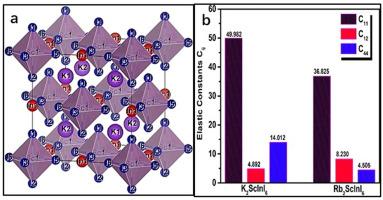First principles investigation of bandgap modulation and light matter interaction in cubic X₂ScInI₆ halide double perovskites for emerging energy applications
IF 4.3
Q2 CHEMISTRY, PHYSICAL
引用次数: 0
Abstract
Double perovskites as promising substitutes to address energy deficiencies, potentially serving as sustainable materials for energy production. The ongoing investigations into these compounds are essential for the advancement of optoelectronic devices. In this work, we conducted an inclusive examination of the properties of X2ScInI6 (A = K, Rb) double perovskite halides utilizing DFT calculations with the all-electron FP-LAPW+lo technique, particularly focusing on replenish able energy sensors. Our findings demonstrate that the energy of formation and Goldsmith's tolerance factor calculations suggest that these halides retain structural and thermodynamic stability in the cubic phase. The stability was further validated by Phonon Dispersion Spectra through the linear response method using the Material Studio code. An evaluation of the elastic properties indicated that the Pugh’s (B/G) and Poisson ratios suggest a ductile nature. We also computed band-gaps in cooperation with TB-mBJ, along with and without spin-orbit coupling (SOC). The bandgap metrics for K2ScInI6 (Eg = 1.965 eV and 1.911 eV) and Rb2ScInI6 (Eg = 1.993 eV and 1.940 eV) were derived using Trans and Blaha modified Becke-Johnson (TB-mBJ & TB-mBJ+SOC) potentials. Additionally, we investigated the optical properties of these halides, focusing on their complex dielectric functions. Our results suggest that these X2ScInI6 (X = K, Rb) halides DPs can be effectively utilized in optoelectronic equipment due to their capacity to absorb light in the UV spectrum. We anticipate that our findings will aid future experimental studies on X2ScInI6 (X = K, Rb) for energy-efficient applications.

立方X₂scii卤化物双钙钛矿中带隙调制和光物质相互作用的第一性原理研究,用于新兴能源应用
双钙钛矿作为解决能源短缺的有前途的替代品,有可能成为能源生产的可持续材料。对这些化合物的持续研究对光电器件的发展至关重要。在这项工作中,我们利用全电子FP-LAPW+lo技术的DFT计算,对X2ScInI6 (A = K, Rb)双钙钛矿卤化物的性质进行了全面的检查,特别关注可补充能量传感器。我们的研究结果表明,地层能量和Goldsmith的容差系数计算表明,这些卤化物在立方相中保持了结构和热力学稳定性。利用Material Studio代码通过线性响应方法进一步验证了声子色散谱的稳定性。弹性性能的评估表明,皮尤(B/G)和泊松比表明延展性。我们还与TB-mBJ合作计算了带隙,以及有无自旋轨道耦合(SOC)。利用Trans和Blaha修正的Becke-Johnson (TB-mBJ &;TB-mBJ + SOC)的潜力。此外,我们研究了这些卤化物的光学性质,重点研究了它们的复杂介电函数。我们的研究结果表明,由于这些X2ScInI6 (X = K, Rb)卤化物具有吸收紫外光谱中的光的能力,因此可以有效地用于光电子设备。我们预计我们的发现将有助于未来对x2sciini6 (X = K, Rb)进行节能应用的实验研究。
本文章由计算机程序翻译,如有差异,请以英文原文为准。
求助全文
约1分钟内获得全文
求助全文
来源期刊

Chemical Physics Impact
Materials Science-Materials Science (miscellaneous)
CiteScore
2.60
自引率
0.00%
发文量
65
审稿时长
46 days
 求助内容:
求助内容: 应助结果提醒方式:
应助结果提醒方式:


